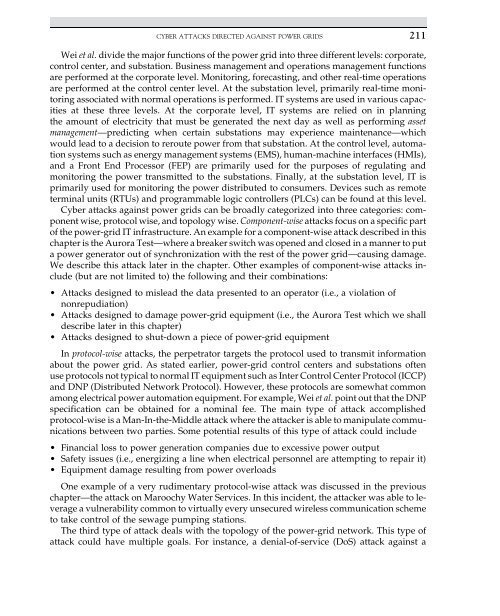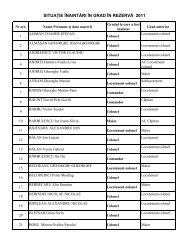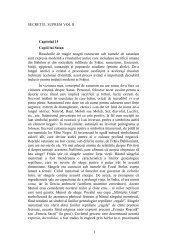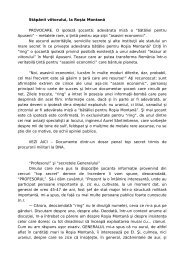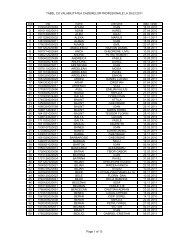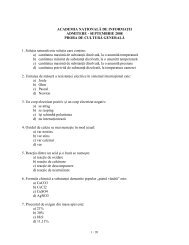Introduction to Cyber-Warfare - Proiect SEMPER FIDELIS
Introduction to Cyber-Warfare - Proiect SEMPER FIDELIS
Introduction to Cyber-Warfare - Proiect SEMPER FIDELIS
Create successful ePaper yourself
Turn your PDF publications into a flip-book with our unique Google optimized e-Paper software.
CYBER ATTACKS DIRECTED AGAINST POWER GRIDS211Wei et al. divide the major functions of the power grid in<strong>to</strong> three different levels: corporate,control center, and substation. Business management and operations management functionsare performed at the corporate level. Moni<strong>to</strong>ring, forecasting, and other real-time operationsare performed at the control center level. At the substation level, primarily real-time moni<strong>to</strong>ringassociated with normal operations is performed. IT systems are used in various capacitiesat these three levels. At the corporate level, IT systems are relied on in planningthe amount of electricity that must be generated the next day as well as performing assetmanagement—predicting when certain substations may experience maintenance—whichwould lead <strong>to</strong> a decision <strong>to</strong> reroute power from that substation. At the control level, au<strong>to</strong>mationsystems such as energy management systems (EMS), human-machine interfaces (HMIs),and a Front End Processor (FEP) are primarily used for the purposes of regulating andmoni<strong>to</strong>ring the power transmitted <strong>to</strong> the substations. Finally, at the substation level, IT isprimarily used for moni<strong>to</strong>ring the power distributed <strong>to</strong> consumers. Devices such as remoteterminal units (RTUs) and programmable logic controllers (PLCs) can be found at this level.<strong>Cyber</strong> attacks against power grids can be broadly categorized in<strong>to</strong> three categories: componentwise, pro<strong>to</strong>col wise, and <strong>to</strong>pology wise. Component-wise attacks focus on a specific par<strong>to</strong>f the power-grid IT infrastructure. An example for a component-wise attack described in thischapter is the Aurora Test—where a breaker switch was opened and closed in a manner <strong>to</strong> puta power genera<strong>to</strong>r out of synchronization with the rest of the power grid—causing damage.We describe this attack later in the chapter. Other examples of component-wise attacks include(but are not limited <strong>to</strong>) the following and their combinations:• Attacks designed <strong>to</strong> mislead the data presented <strong>to</strong> an opera<strong>to</strong>r (i.e., a violation ofnonrepudiation)• Attacks designed <strong>to</strong> damage power-grid equipment (i.e., the Aurora Test which we shalldescribe later in this chapter)• Attacks designed <strong>to</strong> shut-down a piece of power-grid equipmentIn pro<strong>to</strong>col-wise attacks, the perpetra<strong>to</strong>r targets the pro<strong>to</strong>col used <strong>to</strong> transmit informationabout the power grid. As stated earlier, power-grid control centers and substations oftenuse pro<strong>to</strong>cols not typical <strong>to</strong> normal IT equipment such as Inter Control Center Pro<strong>to</strong>col (ICCP)and DNP (Distributed Network Pro<strong>to</strong>col). However, these pro<strong>to</strong>cols are somewhat commonamong electrical power au<strong>to</strong>mation equipment. For example, Wei et al. point out that the DNPspecification can be obtained for a nominal fee. The main type of attack accomplishedpro<strong>to</strong>col-wise is a Man-In-the-Middle attack where the attacker is able <strong>to</strong> manipulate communicationsbetween two parties. Some potential results of this type of attack could include• Financial loss <strong>to</strong> power generation companies due <strong>to</strong> excessive power output• Safety issues (i.e., energizing a line when electrical personnel are attempting <strong>to</strong> repair it)• Equipment damage resulting from power overloadsOne example of a very rudimentary pro<strong>to</strong>col-wise attack was discussed in the previouschapter—the attack on Maroochy Water Services. In this incident, the attacker was able <strong>to</strong> leveragea vulnerability common <strong>to</strong> virtually every unsecured wireless communication scheme<strong>to</strong> take control of the sewage pumping stations.The third type of attack deals with the <strong>to</strong>pology of the power-grid network. This type ofattack could have multiple goals. For instance, a denial-of-service (DoS) attack against a


